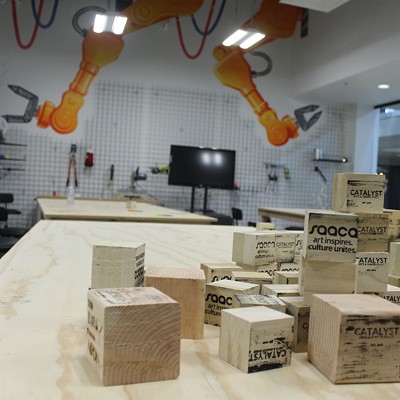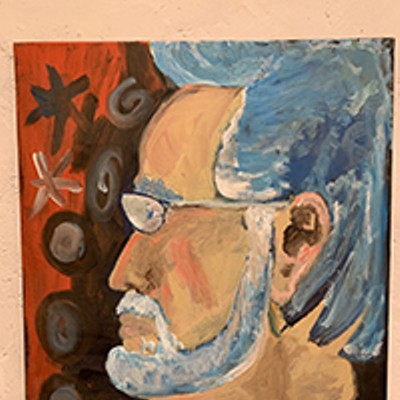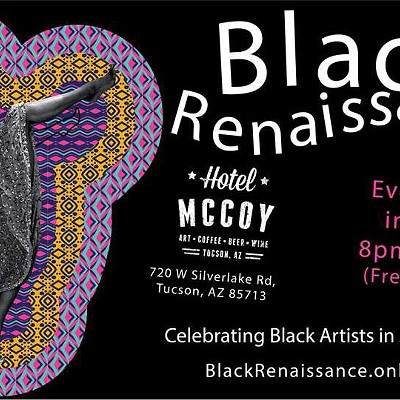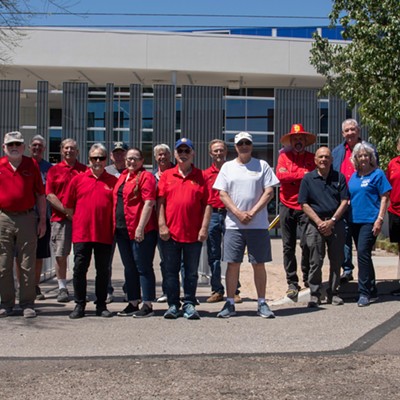I was traveling with Gerta, the beautiful young German woman who was not yet my wife. We headed out from Tucson with DeGrazia and his wife Marion in DeGrazia's big Mercedes. Along with attending Indian ceremonials, DeGrazia, a fanatic about color, was also looking for a red blanket of a certain shade. He'd been searching for months and he was sure he'd find it in New Mexico.
I don't recall where we stayed in Santa Fe, our first stop, but I remember being surprised at how shocked DeGrazia was when he learned that Gerta and I would be sharing the same room. I guess it just wasn't done in those days. I also recall that we shopped under the portals at the Palace of the Governors on the Santa Fe Plaza; I still have the turquoise and silver cuff links I bought there. I understand cuff links are coming back.
We went on to Taos where we paid a perhaps too-early-in-the-morning visit to the writer Frank Waters, a friend of DeGrazia's. I had a copy of Water's The Man Who Killed the Deer that I was hoping to have autographed.
Unannounced visits are quite common in the West, but ours couldn't have been more badly timed. Waters was just sitting down to breakfast and was obviously having a tiff with his then-wife. Our arrival--"paying homage to the great writer" was his wife's ironic phrase, I think--set her off. A plate of scrambled eggs went flying across the kitchen, smashing into the wall. We could still hear the shouting as we got into the car. I never did get the book signed.
On Christmas Eve, we headed out to services at Taos Pueblo. There was a huge crowd and no place to sit; we squeezed into the church balcony. A tall, powerfully built Indian standing next to me lit a cigarette. I told him he shouldn't smoke in church. He told me that we were in an "Indian place" and he'd smoke if he wanted to. I wasn't about to argue.
After the priest said Mass, two Indian Deer dancers, bedecked in deerskins and antlers, came thumping down the center of the church aisle, rattles shaking, chanting; they were followed by others and then by a Buffalo dancer. DeGrazia sketched away.
At Nambe Pueblo, where we went next, we were surprised to discover the same priest celebrating Mass. In fact, this priest was at every pueblo we visited that night, eventually saying "midnight" Mass at 2 in the morning at Santa Clara. Somewhere along the way we got arrested. Driving down a long dirt road to one of the pueblos, we picked up a Native American who was going in the same direction. On leave from a military base, I believe, he was quite young and quite drunk, and it was the latter condition that found all four of us being led to the office of the tribal governor, who was apparently also a judge.
It was a serious offense, we were told, bringing alcohol into the pueblo. We hadn't, but because the intoxicated young Indian was with us, it was assumed that we had contributed to his condition. For a while, it looked as though we were going to spend the rest of Christmas Eve in jail, but then DeGrazia had a brainstorm. He opened his wallet and slowly laid out a string of credit cards, all gleaming plastic and bright colors. Credit cards were hardly as common then as they are now. The governor-judge picked up each card and studied it carefully, running his finger over the embossed lettering. What message they transmitted, we don't know, but they did the trick. The cards were returned, and we were promptly released.
It was late and everyone was exhausted, but DeGrazia wanted to press on. An impressionistic artist, he painted Indians with stylistic brilliance in a dazzling palette of colors. For the moment, however, he was making only quick pencil sketches. The more tired he was, he explained, the more blurred everything became, and only the most important details stood out. He worked best in that dreamlike state. His UNICEF Christmas card, Los Niños. a swirling ring of Indian and Mexican children hand in hand, had just come out. It later went on to break all UNICEF sales records for the international organization's fund-raising greeting cards.
Before visiting the pueblos, Gerta and I noticed a blanket in the window of the local JC Penny. It was red, a terrible color red, somewhat reminiscent of Campbell's tomato soup. We bought it anyway, had it gift wrapped and gave it to DeGrazia on Christmas morning. He seemed touched when he opened the box; it was just the color he was looking for, he said, trying to keep a straight face. How did we ever find it?
DeGrazia died in 1982. Frank Waters died in 1995. Marion DeGrazia died last week at the age of 97. The marvelous Taos pueblo now has a casino at its entranceway. My marriage to the beautiful German girl was a disaster, but we're still friends and she's still beautiful. Our two children are grown now, both inveterate travelers. I only hope that of all the places they go at least one will provide the warmth and wonder and magic of that Christmas night with DeGrazia.












